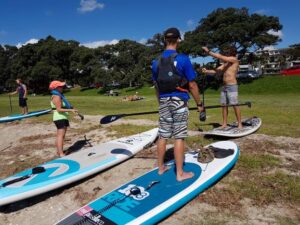How to get into SUP
Stand-up paddleboarding is actually much easier than it looks. In fact, anyone with a reasonable degree of fitness can probably figure it out for themselves, if they’re given appropriately sized equipment and have the right wind/water conditions. (We’re not talking surfing here; waves should not be tackled until you’ve mastered the basics on flat water, even if you’re already a competent surfer). Once you’ve got yourself standing up, and the paddle in the water, you’re pretty much there – all you need now is more practise to improve your balance and paddling skills – and of course, to make sure you’re doing it safely.
Yes, safety. Paddleboarding is essentially a very safe pastime, but any water activity carries with it a degree of risk. Fortunately, it’s extremely easy to minimise the risks, if you know how. Check out the safety pages on this website, and our completely free online and classroom SUP SAFE courses here
Choosing your first board
Should I get a lesson?
 Many people teach themself – but most end up with bad habits, particularly in their paddling technique. As with pretty much any sport, being taught properly by an experienced instructor, on equipment specifically designed to make the early sessions as easy and painless as possible, is a vastly more efficient and effective way of learning. If you don’t have much experience at watersports, are suffering any injuries or disabilities, or maybe just aren’t feeling too fit at the moment, then proper lessons are definitely a good plan. The learning curve will be far steeper, you can leave all the worrying about safety and weather conditions etc to your instructor, and you’ll not be picking up any bad habits (which, once engrained into your technique, are often very hard to shift). Better still, as there isn’t any one ‘right’ way of paddling (just as there isn’t one right way of walking or running, or any other repetitive motion activity), a good instructor will be able to equip you with the right techniques for you – taking into account your bodyweight, shape, height, age and fitness level. And then, having seen what works best for you, give you good advice on what equipment you should be considering for your first purchase.
Many people teach themself – but most end up with bad habits, particularly in their paddling technique. As with pretty much any sport, being taught properly by an experienced instructor, on equipment specifically designed to make the early sessions as easy and painless as possible, is a vastly more efficient and effective way of learning. If you don’t have much experience at watersports, are suffering any injuries or disabilities, or maybe just aren’t feeling too fit at the moment, then proper lessons are definitely a good plan. The learning curve will be far steeper, you can leave all the worrying about safety and weather conditions etc to your instructor, and you’ll not be picking up any bad habits (which, once engrained into your technique, are often very hard to shift). Better still, as there isn’t any one ‘right’ way of paddling (just as there isn’t one right way of walking or running, or any other repetitive motion activity), a good instructor will be able to equip you with the right techniques for you – taking into account your bodyweight, shape, height, age and fitness level. And then, having seen what works best for you, give you good advice on what equipment you should be considering for your first purchase.
It’s not just about the very first steps, either. On your subsequent lessons your instructor can introduce you to all the different stances, turning techniques, different types of paddle stroke, and generally improve and refine your all-round technique. They’ll also bring you up to speed on safety aspects of the sport, and how to interpret and make the most of the wind and weather conditions, so that when you get out there on your own, you’ve got all the knowledge you need for enjoyable and safe paddling.
If you’re looking at getting into paddlesurfing, then a good paddleboarding school or coach will offer a series of flat water lessons to build up your turning, accelerating and manoeuvring skills. Check out the SUP schools that we know about here.
